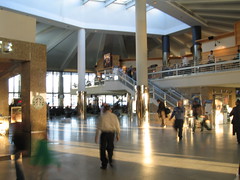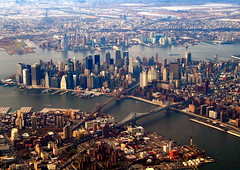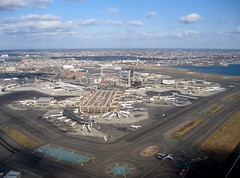This recent article in Salon, which reviewed the readers’ favorite (and least) airports, got me thinking about my own relationship with airports.

Relationship? What?
Look, I should lay it out now: I love airports. Yes, the same places that inspire government stupidity, passenger rage, and supernatural wrath. Whatever they are to other people, airports are – to me – comfortable and easy places that hold the reliable promise of something good. That good is might come in the form of the excitement of a new destination, an interesting lounge conversation, or simply the comfort of the familiar. But it’s almost always good.
So, with that in mind, here is the Mark Blacknell Review of Select Airports, International and Domestic:
First, we visit my reliable favorites. These are the places that, over the years, have come to be my regularly transited crossroads, and do a decent job of it. So that start us off with . . .
DCA
National Airport is just about everything an airport should be – convenient to access, easy to move through, and gets you where you want to go. It’s not just a sub-10 minute cab from my house, but you can get from Terminal B to K St. in 20 minutes or less, most days. It’s very well laid out, with minimal door to terminal time (unless you’re unfortunate enough to book one of the budget airlines that flies out of Terminal A). The building itself is beautiful – the giant glass main hall (for terminals B and C) is perfect for an airport, giving lots of space and raising your eyes to the sky.
 In addition to great design, DCA has that rarest of rares: competent and (almost always) decent TSA agents. Perhaps its because they run the daily risk of pissing off someone who could end their careers, but they seem to be uniformly polite and reliable applicators of a standard set of rules. How many airports can you say that about? The only things I could realistically ask for, as far as improvements go, is free wi-fi and taxi line managers that aren’t confused by the concept of a line (my most shameful public outburst was provoked by one of these guys . . . ).
In addition to great design, DCA has that rarest of rares: competent and (almost always) decent TSA agents. Perhaps its because they run the daily risk of pissing off someone who could end their careers, but they seem to be uniformly polite and reliable applicators of a standard set of rules. How many airports can you say that about? The only things I could realistically ask for, as far as improvements go, is free wi-fi and taxi line managers that aren’t confused by the concept of a line (my most shameful public outburst was provoked by one of these guys . . . ).
In short, I couldn’t ask for a better home airport. It lacks only one thing – international flights (sorry, Canada, you don’t count). Which is why the next two airports are often on my list.
JFK
JFK is everything DCA isn’t. It’s crowded, dirty, and a nightmare to navigate.  I think there’s a desperate competition between it and LaGuardia to see which can produce more bitterness in its staff. But even with all of that, I’ve come to develop a grudging appreciation for it. It gives a sense of being a crossroads for the planet, something that, say, Atlanta never achieves (though it may have a better technical claim). And it’s as a crossroads that I always use it (from DC, the train is generally the less troublesome (and quicker) way to get to where you’re going in NYC). I’ve marked many a milestone there, and expect to mark many more.
I think there’s a desperate competition between it and LaGuardia to see which can produce more bitterness in its staff. But even with all of that, I’ve come to develop a grudging appreciation for it. It gives a sense of being a crossroads for the planet, something that, say, Atlanta never achieves (though it may have a better technical claim). And it’s as a crossroads that I always use it (from DC, the train is generally the less troublesome (and quicker) way to get to where you’re going in NYC). I’ve marked many a milestone there, and expect to mark many more.
I suppose I should come up with a couple of positive things about JFK, lest the reader think that this is the start of a descent into complaints. First, if you fly through JFK next year, you should make your way (if you can) over what remains of Terminal 5.

Designed by the Eero Saarinen (who also gave us the only good thing about Dulles – the inspired main terminal building), it used to form the hub of TWA’s glory years operations. And then there’s the views.
Few views can match that which you get on an eastern approach, and you certainly won’t be getting them from an Acela seat . . .
ATL
Atlanta’s Hartsfield-Jackson is the airport people love to hate. I don’t understand that, really. It’s big, to be sure, but it’s quite logically laid out, and I challenge you to need something that you can’t get at the airport. Good food? Check. Replacement electronics? Check. A tie to replace the one you forgot? Check. Peace and quiet? Well, okay, it’s not perfect. But there are direct flights from ATL to pretty much every city of any size on the planet. What more could you ask for from an airport?
Well, I suppose you could ask for an end to the construction.  Or security guards that at least *pretend* to pay attention. And while I’m at it, I’d like Chapter 11 to reopen the 24 hour bookstore they used to have there. But that’s all frosting, really. ATL is functional, and I appreciate it for what it is. It was my home airport for years and years, from which I learned many a lesson. I waited outside of its international arrivals for my grandparents there as a child. I tried my hand at petty theft there as a teenager. And I’ve stretched out in the Crown Room, martini in hand and waiting for my flight home as an adult. It’ll always be home to me.
Or security guards that at least *pretend* to pay attention. And while I’m at it, I’d like Chapter 11 to reopen the 24 hour bookstore they used to have there. But that’s all frosting, really. ATL is functional, and I appreciate it for what it is. It was my home airport for years and years, from which I learned many a lesson. I waited outside of its international arrivals for my grandparents there as a child. I tried my hand at petty theft there as a teenager. And I’ve stretched out in the Crown Room, martini in hand and waiting for my flight home as an adult. It’ll always be home to me.
So those are my functional and sentimental favorites. On to the other airports.
BOS
Logan only arrived on my radar in the past few years. When I started flying there (via US Airways or a Delta Shuttle), I usually disembarked to some pretty appalling conditions. The decrepit gates were the sort that you’d usually think were reserved for the once a day flight to MacArthur or some other unfortunate destination.

And getting a taxi turned out to be such an exercise in exasperation that Logan can claim credit for turning a car service from an occasional luxury into a reasonable option.
So it’s not like we started off on the best foot. But, I’m happy to say, things have changed. The new Delta Terminal A is wonderful – brightly lit and spacious (perhaps too spacious, but that’s Delta’s problem to fix). The food options, which were well below average, have improved (to average. But hey, it’s progress). It’s not a preferred airport for me, but it’s one that doesn’t bother me when I see it on an itinerary.
SFO
Despite its greatly inconvenient distance from San Francisco, I quite like SFO. Unlike most other airports, I’ve never seen it dirty or in need of repair. I can’t recall any unreasonable waits for security. The terminals are easy to navigate, and the food is good. One other thing that I’ve always enjoyed about SFO: great museum and art displays in the walkways. Seriously, most airport public art is safe and not at all interesting (how many Mrs. Cooper’s Fourth Grade class drawings can you really take?), but I’ve always found something worth stopping for on the way to the terminal. Deep sea oddities. Miniature models. Russian dolls. Between that and a generally quiet and chill atmosphere, this is one airport for which I don’t mind an early arrival.
LAS
Now we’re talking about airports I can’t stand. Las Vegas’ McCarran tops my list.

To call it my own personal hell isn’t too much of an overstatement. Perpetually overcrowded by clueless travelers who book bottom dollar tickets, thus promoting bottom dollar service. It actually pales in comparison to my general dislike of Las Vegas itself, but it has all the same ingredients – design where function is sacrificed on the altar of garishness, service that can’t even manage the illusion of cleanliness, and did I mention the teeming masses?
IAD
Dulles *should* be my second favorite airport. It’s the closest international airport, and certainly has a good number of flights. But I do my damnedest to avoid it. Why? For starters, it’s a pain in the ass to get to. Sure, you can bypass most of the Dulles Toll Road to get there, but first you have to get to the bypass. And for me, that means sitting in slow moving traffic on I-66. So take the Metro there, right? Bzzt. Wrong. Yes, ladies and gentlemen, there is no train link between the city and the primary international airport for Washington, DC. Not only is there no train link, there’s no public transportation link. At present, the best public transport solution is something of a hybrid – take the Metro to West Falls Church, and then wait around for one of the private shuttles to get going. And that’s just getting there.
Once you’re there, you are almost certain to spend a ridiculous amount of time in the security lines. I’ve spent two hours in a security line at Dulles, and that’s not an unusual experience. Hopefully this has changed, as the airport finally got around to opening up a second security checkpoint section to funnel passengers through. Of course, a cynic might note that this will just provide double the space in which the Worst TSA Agents Ever can practice being unreasonable, obtuse, and overzealous. Anyway, don’t worry – the fun doesn’t stop here.

Once you’re through security, you get to experience the revenge of some embittered bureaucrat from the 1960s – the Dulles Moon Buggies. Maybe the designer’s cousin owned the company that provided them, or perhaps it was a joke played on an unwitting airport authority by engineers who wanted to see how ridiculous they could be before getting called on it. Whatever it was, it certainly wasn’t common sense or good design that saddled IAD with the worst interterminal transport system in the United States.
What? The photo looks old and crappy and poorly executed? Then yes, I’ve captured the Dulles people movers perfectly. By the time that you get to the terminals, it doesn’t matter that it’s luck of the draw on food, and that some of them look like they’ve not seen a good coat of paint since the late 80s. Given a choice between a direct flight out of Dulles and something out of National that requires a stop? National, almost every time.
Other US Domestic Airports
Many airports leave little to no impression – I’ve been through Newark, Phoenix, and Cincinnati a number of times, but I couldn’t tell you anything about them. Many would consider that a success, thinking of airports as mere conduits through which people should pass with a minimum of drag. That’s a shame. While I agree that an airport should make it easy to pass through quickly, I think it should work to be a symbol of its region, giving visitors a flavor of the place they’re about to see (or are just passing through). The Twin Cities’ MSP does a serviceable job of that, if only because the Hubert H. Humphrey Terminal signs always have me humming this song when I pass through. Vancouver’s YVR does an excellent job of conveying that you’re in the Northwest, and I’ll explore that in the next installment.
In the meantime, some airports may not leave much of an impression, but do yield great pictures, such as this one from DFW:

Next: Beyond US Airports










 There’s a great discussion going on over at TPMCafe on the new book,
There’s a great discussion going on over at TPMCafe on the new book,